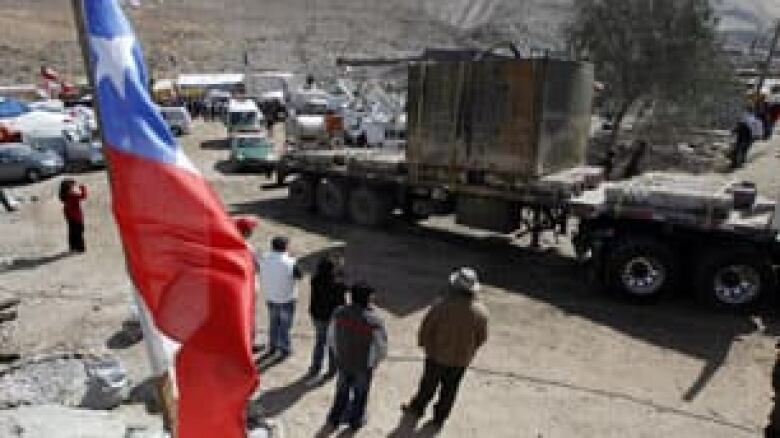Trapped Chilean miners get 1st supplies

Through a newly installed communications system, each of the men spoke and reported feeling hungry but well, except for one with a stomach problem, a Chilean official said. They requested toothbrushes.
It was a positive sign, andPresident Sebastian Pinera said the nation was "crying with excitement and joy" after engineers detected the men were alive Sunday using a probe. It had been 17 days since an Aug. 5landslide at the gold and copper mine in northern Chile caused a tunnel to collapse and entombed them 670 metres below ground.
But with a rescue planthat could take up to four months to complete, doctors and psychological experts said they were implementingways to safeguard the men's sanity, including keeping them informed and busy.
"They need to understand what we know up here at the surface, that it will take many weeks for them to reach the light," Health Minister Jaime Manalich explained.
Dr. Sergio Aguila, a physician on the rescue team, said the miners reported that they fed themselves with cans of tuna, milk and biscuits stored in the shelter where they took refuge after the tunnel collapsed.
"They had two little spoonfuls of tuna, a sip of milk and a biscuit every 48 hours," he said. He did not say how long the supplies lasted.
The initial work

The lubricant makes it easier to pass supplies through in capsules nicknamed "palomas," which is Spanish for dove. The first of the packages, which are about two metres long and take about an hour to descend from the surface, held rehydration tablets and a high-energy glucose gel to help the miners' digestive systems.
Rescue teams also sent oxygen down after the miners suggested there was not enough air in the stretches of the mine that run below where the main shaft collapsed.
The shelter, a living-room-sized chamber off one of the mine's lower passages that is easily big enough for all 33 men, is far enough from the landslide to remain intact, and the men can also walk around below where the rocks fell.
Food will be sent down in several days after the men's stomachs have had time to adjust, said Paola Neuman of the medical rescue service.
Rescuers also sent down questionnaires to determine each man's condition, along with medicine and small microphones to enable them to speak with their families during their long wait. Rescue leader Andre Sougarret said they were organizing the families into small groups to make their talks as orderly as possible.
Drilling to provide better conditions
Meanwhile, an enormous machine with diamond-tipped drills capable of carving a 66 centimetre-wide tunnel through solid rock and boring at about 20 metres a day was on its way from central Chile to the San Jose gold and copper mine, outside Copiapo in north-central Chile.
The machine was donated by the state-owned Codelco copper company and carried on a truck festooned with Chilean flags. Just setting it up will take at least three days.
Engineers were also boring two more narrow shafts to the trapped men, but stopped Monday just above their refuge while they made sure that the lifeline was fully secure. Only when these three shafts are complete will they begin carving out the tunnel large enough to fit a man, Mining Minister Laurence Golborne said.
"We cannot be 100 per cent precise, but the idea is to establish three or four points of contact so that we can guarantee better life conditions to our comrades down there," he said.
Besides their immediate physical needs, such as medicine to restore their raw stomachs and sleep cycles, the rescuers were preparing psychiatric counselling. A first step was the questionnaires, which were also intended to help identify their natural leader someone who can make sure the men are keeping busy and mentally focused.
Miners' families
Above ground, rescuers and family members thought that might be Mario Gomez, who at 63 is perhaps the oldest of the veteran miners down below. Gomez's letter to his wife, Liliana, which the miners tied to the drill bit, was full of expressions of faith and determination, revealing to the world that the miners were holding strong.
"Even if we have to wait months to communicate I want to tell everyone that I'm good and we'll surely come out OK," Gomez wrote, scrawling the words on a sheet of notebook paper. "Patience and faith. God is great and the help of my God is going to make it possible to leave this mine alive."
ButLuis Urzua, 54, was the shift foreman at the time of the collapse, and Golborne said Monday that "it seems the miners respect hierarchies."
For the miners' families, euphoria and anxiety made for a sleepless night. They shivered through the cold and fog in Chile's Atacama desert. Twenty-four familieshave filed a lawsuit against the company and the government, Eva Salinas, editor of the Santiago Times told CBC News.
The men already have been trapped underground longer than all but a few miners rescued in recent history. Last year, three miners survived 25 days trapped in a flooded mine in southern China, and two miners in northeastern China were rescued after 23 days in 1983.
Few other rescues have taken more than two weeks.
With files from CBC












_(720p).jpg)


 OFFICIAL HD MUSIC VIDEO.jpg)
.jpg)



























































































